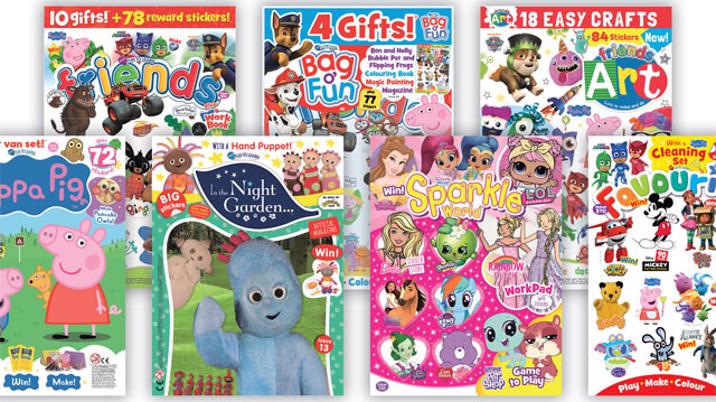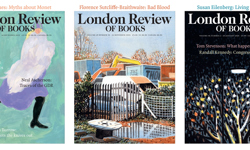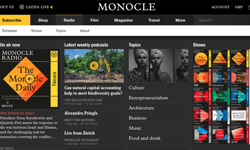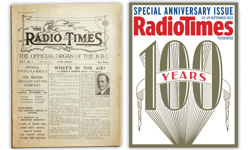
While the children’s magazine market has long been one of publishing’s more robust sectors, rising cover prices have recently taken their toll. Yet Redan Publishing, with its pre-school and primary-age portfolio including brands such as In The Night Garden and Peppa Pig, is one company bucking this trend. And, according to Managing Director Julie Jones, it’s down to what’s always driven success at this – the youngest – end of the publishing market: staying on top of new licensing properties and open to the latest innovations.
Not so long ago, a typical £1.99 per issue cover price meant a child might be bought two, three or even four titles a month but a recent rise by publishers to £3.99 has resulted in fewer copies bought. Furthermore, with the bulk of sales via supermarkets, a child is increasingly likely to be given an adult’s smartphone or tablet to keep them occupied while in tow for the weekly shop.
Meanwhile, more publishers are moving from other sectors into children’s publishing at a time when, thanks to platforms such as You Tube, Netflix and Amazon bringing more opportunities to launch new characters, a growing array of licensed products are now competing.
Typical lifespans of magazines for this young group of readers has shortened, however – from a couple of years to as little as six months in some cases. And according to one estimate, the sector average number of successful launches that stay the course has dwindled over the past decade from one in three to closer to one in eight.
And yet despite all this, Redan is growing.
“The start of this year was a good one, with figures from our distributors up to the end of May showing we were up 1.5% in term of volume and 11% retail sales for the year while turnover for the first six months to the end of June was up 8%,” says Jones.
“Though the second half of the year is historically weaker for us, we expect to be up overall this year at a time when overall sales of children’s titles are down 11% by volume and 5.5% in retail sales (again, over the year to end of May 2018). And the reason for this is our strong portfolio.”
For all publishers, resilience in today’s unpredictable market – even in a sector which, until recently, was regularly described as historically buoyant – depends on agility, flexibility and not putting all your eggs in one basket. But this is even more so in children’s publishing when you are producing magazines based on licensed characters, the popularity of which is notoriously difficult to predict and vulnerable to shifts in taste or fashion.
Established in 1988 and co-founded by the late Robert Sutherland, former CEO of Marvel UK, Redan now has a 26-strong UK workforce and a current line-up comprising eight titles.
Peppa Pig pays
With sales of 66,314 (ABC, Jan-June 2018 – up 6% period on period), Fun to Learn - Peppa Pig is its largest fortnightly. Redan’s Fun To Learn - Peppa Pig Bag o’ Fun, published four-weekly and with 85,455 sales over the same period, is officially the UK’s number one children’s magazine (sales and volume) and in the year June 2017-May 2018 generated £5.1m at retail.
Also in the pre-school portfolio are Fun To Learn - In The Night Garden – another TV licensed property, and a clutch of compilation titles featuring a mix of licensed characters: Fun To Learn - Friends, Fun To Learn - Favourites, Fun To Learn – Bag o’ Fun, recently-launched Fun To Learn - Friends Art and, specifically for girls: Sparkle World.
With a self-imposed ceiling of advertising representing no more than ten per cent of content in each title, the bulk of the business’s revenue comes from retail sales.
The compilation titles provide a powerful platform to test new properties and a format strong and flexible enough to adapt to changing tastes in characters or styles of content – by replacing older properties when they grow tired with new ones, explains Jones, who joined the business fifteen years ago as marketing manager from Midland News Association and became publishing director two years later, then managing director in late 2016.
Star performer for the business is, without doubt, Peppa Pig – the evergreen animated children’s favourite first launched in her own eponymous TV series on Channel 5 in the UK back in 2004, created by production company Astley Baker Davies, now part of entertainment distribution company Entertainment One.
“We had Peppa first in Fun To Learn – Friends – before anyone had her on their radar, which was when we proposed doing a standalone Peppa magazine,” she says.
The move paid off and Peppa has been a publishing success for the business for many years. It was a gamble, however.
The licensor dynamic
While licensors tend to want to licence characters before they are proven (and, often, launched), publishers will obviously want to minimise their risk by investing in characters with the greatest chance that they will work. But once a character is a proven hit, the price they can command from potential licensees pitching for licensing rights is likely to be high.
“The biggest challenge we face is choosing the right property in the first place,” Jones continues.
“No-one knows in advance what will be a hit and what won’t be, so often it’s down to gut feel. That said, we believe what works best for publishing will be those with the best storylines because that’s what children best relate to – they want great stories and they want to be entertained.”
Also a challenge is striking the right balance between delivering the readers and engagement a licensor wants for their character and pushing the envelope creatively. “Inevitably, as a publisher you want to innovate,” she says.
“And, at Redan, we pride ourselves on going beyond the standard formats, sizes and so on – initially at least, to see what will work.”
What drives everything the business does is the need to meet the needs of its consumers, for something that adds value. And that means both the children who read its titles and the adults who buy them, for the education through entertainment proposition.
She adds: “It’s why quality is very important to us – not just in terms of the physical format we create, but also the content we deliver which must be the very best it can be. And this is ultimately where the licensors’ interests lie: in seeing the longest engagement possible between our title and a child.”
Screen-free time
This is one reason why digital’s impact has affected the children’s sector of the magazine market differently to others.
“Three or four years back, we created a Peppa Pig app, but it didn’t work for us. The product was fabulous, but financially it was unsustainable as people expect content for free,” Jones explains.
“More than this, though, our content is packed with stories and activities and designed to be subtly educational requiring the child to actively participate – for example, by practising their handwriting skills. In this respect, it’s difficult to adapt for a screen. On top of which, we’ve been promoting screen-free fun across all our products for years, so for our target market, the tangible product is key.”
Covermounts have always played an important role in the tangible product – and now, at a time when cover prices have risen and market volume sales are in decline, even more so. As a result, they’ve been getting more frequent and bigger and bigger.
“Everyone thinks they know what will work best as a covermount, but it is often a surprise to them what does and doesn’t,” Jones continues.
“We have to be careful to find something that can give a child hours of fun rather than just being a throw-away. People want play value – and that means licensors, too, as it’s all about engagement. We work to come up with something new and different – we don’t just buy something off the shelf, so we try hard to see what’s out there and add to it or tweak.”
Covermount logistics such as weight and associated postage are one reason why Redan’s business has traditionally been almost entirely driven by retail sales; young finite life-span as readers has been another. However, work is now underway to grow the publisher’s modest subscription business.
Subs opportunities
“As the children who read us inevitably out-grow us after a number of years, we need a new subscription model,” she reveals. “And this is something we will be addressing over the months ahead.” Another priority will be continuing to develop new titles and invest and innovate existing ones to keep them fresh. And this, in today’s fast-moving digital world, is proving increasingly challenging.
Spotting and tracking new and emerging licensable properties as the number breaking through via streaming platforms rather than broadcast TV continues to grow – is increasingly tricky, for example. Yet, at the same time, the growing success of Lego – powered in part by its successful extension into digital products, movies and now publishing – has created new opportunities by helping to address young boys’ traditional reluctance to read.
“In five years’ time, what I most hope for is that Redan is as successful as it is today, with sales still strong and a portfolio that’s a bit bigger,” Jones says.
“It’s fun to try new things and enter new markets – as we did a while back with the adult colouring book market, for example, which worked for a while. But we have learned through experience that we are most successful when we focus on what we do best. In the children’s market – a market that is exciting and fun and diverse and constantly changing everyday – new characters are always being launched.”
She adds: “So the good news for us is there are always plenty of opportunities.”












